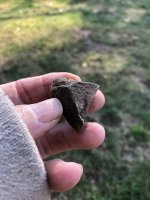But alas, not worth much of anything. I went to a 1740's metal foundry about 60 miles from where I live in the middle of nowhere. Found a few 18th century buttons, a ladies copper engraved pin and a brass wedding ring, plus some lead ingots which were given to Revolutionary War soldiers to make their own musket balls.
The find of the day was a silver hunk of apparently smelted metal. It was too light for lead or high carat gold. Too light for magnesium, aluminum, bismuth, or beryllium. Had a specific gravity of 6.4. Not magnetic but as it wasn't tarnished I thought an amalgam (mix) of silver and something else.
I had it professionally analyzed. It was 62% TIN and 38% iron! Well, tin was not mined in the US until it was discovered in 1880! This hunk of tin would have come from Cornwall, England, by the time of the Revolution. If you remember history, one of the reasons we had the revolution was the crown would not let us mine our own minerals. So for the historian in me, it's really cool.
The find of the day was a silver hunk of apparently smelted metal. It was too light for lead or high carat gold. Too light for magnesium, aluminum, bismuth, or beryllium. Had a specific gravity of 6.4. Not magnetic but as it wasn't tarnished I thought an amalgam (mix) of silver and something else.
I had it professionally analyzed. It was 62% TIN and 38% iron! Well, tin was not mined in the US until it was discovered in 1880! This hunk of tin would have come from Cornwall, England, by the time of the Revolution. If you remember history, one of the reasons we had the revolution was the crown would not let us mine our own minerals. So for the historian in me, it's really cool.
Attachments
Upvote
18







